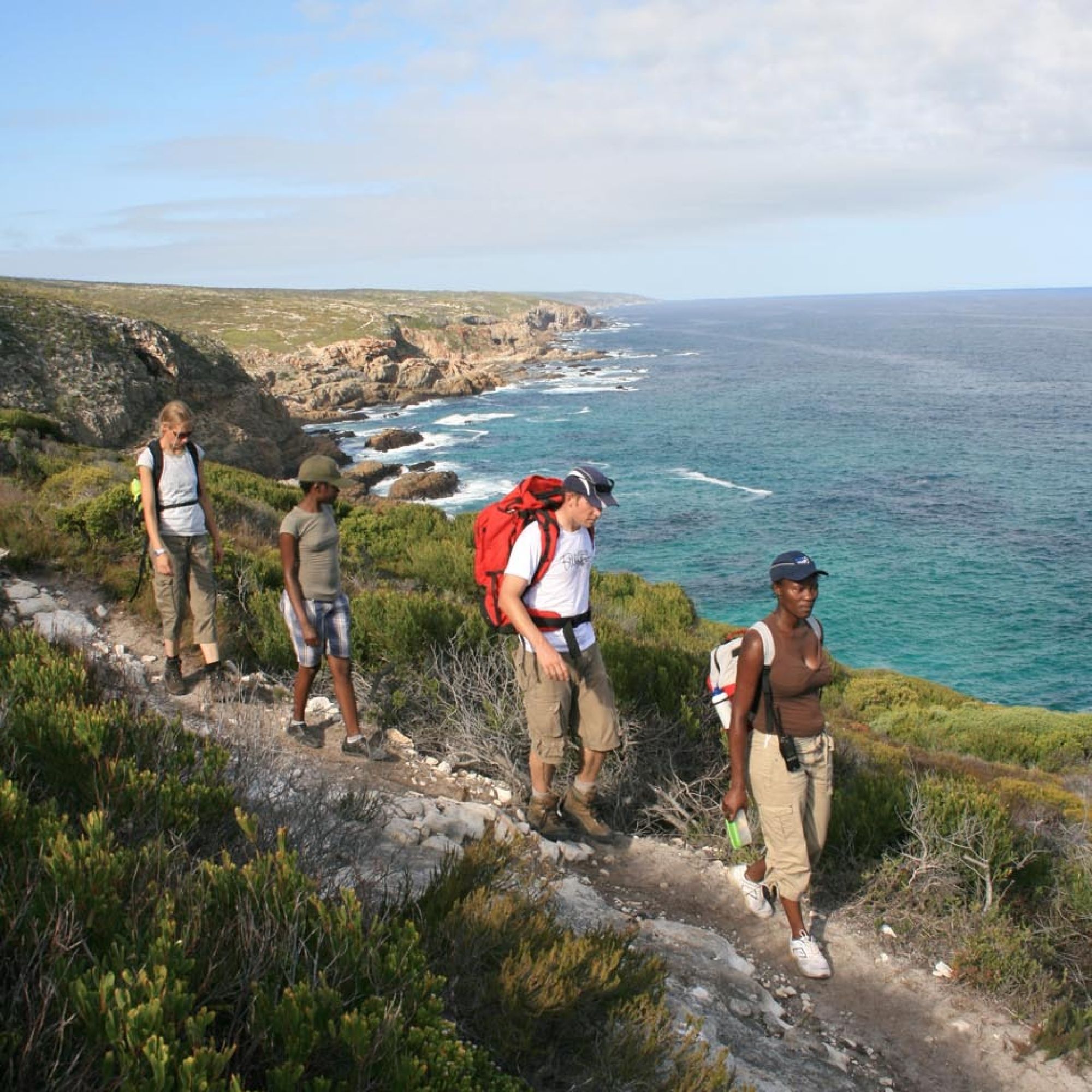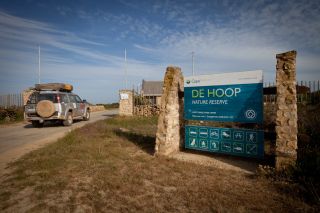Hiking

If you’re a keen hiker, it will take you many years to explore all the spectacular, scenic trails – from easy, short walks to challenging multi-day hikes – that CapeNature reserves have to offer. Here’s a look at what you can expect:
If dramatic mountainous terrain, wild indigenous forests and lush mountain fynbos appeal to you, head to Boosmansbos Wilderness Area, next to the Grootvadersbosch Nature Reserve in the Langeberg Mountains. Only 12 hikers a day are allowed on the 64km of marked trails traversing the conservancy’s 14 200ha, so it’s essential to book in advance. The two-day Wilderness Trail follows an old jeep track. Look out for buck, mongooses and genets. There are leopards in the area, too.
The famous and scenic Cederberg Wilderness Area has a range of hiking trails that vary in intensity, including routes to fascinating rock formations such as the Maltese Cross and Wolfberg Arch, as well as to waterfalls.
Located in the Matjiesrivier Nature Reserve, 45km up the road from Algeria camp in the Cederberg Wilderness, the Stadsaal Cave is a unique and special part of South African history. It takes about 30 minutes to walk around at a leisurely pace, although you might find yourself taking much longer to absorb and appreciate the wonder of these unique rock formations.
Truitjieskraal, part of Matjiesrivier, has arguably some of the most impressive sandstone formations in the area and is highly recommended by rock climbers.
The trails along the Cederberg Heritage Route cater for everyone – from beginners to experienced hikers. The route offers overnight and shorter hikes – from three to eight hours long. If you’re a hiking enthusiast who’s up for a challenge, the Cederberg 100 Trail is an eight-night trail covering about 100km.
All keen hikers aspire to do the Whale Trail in the beautiful De Hoop Nature Reserve. Perfect for a soul-soothing break, this multi-day hike of about 55km traverses stunning coastal scenery and offers the chance to spot whales along the coastline (De Hoop is known as one of the best land-based whale-watching spots in the world).
The Whale Trail is an unforgettable experience, taking you through one of the Western Cape’s most unique and diverse nature reserves, from Potberg to Koppie Alleen, with five overnight stops (you’ll spend the first night at Potberg before starting the trail).
The Klipspringer, Potberg and Coastal trails will also immerse you in De Hoop’s rich flora and wildlife.
Also along the coast is the magnificent De Mond Nature Reserve at the mouth of the Heuningnes River, about 26km south-east of Bredasdorp on the south-western Cape coast. De Mond has two scenic hiking trails to enjoy. Be sure to also visit the Waenhuiskrans Cave near Arniston, which is only a short walk from the parking area at Roman Beach.
For a very different hiking experience, head to Gamkaberg Nature Reserve in the Klein Karoo, with its spectacular viewpoints. There are several route options, including the overnight Tierkloof Hiking Trail over fairly rough terrain. The Gamkaberg day trails take you through the Succulent Karoo and subtropical thicket.
The Garden Route offers a vast range of activities, including hiking. The Goukamma Nature Reserve boasts six hiking trails, varying in their duration (from two to six hours) and required fitness levels. Expect exquisite scenery, with many birdwatching opportunities along the way.
The Blombos Route is popular with birders, while the Bush Pig Trail offers great sea views and whale watching from June to November. Be aware that the Galjoen Trail is inaccessible during spring high tide.
For something wild and wonderful, head to the Groot Winterhoek Conservation Areanear Porterville, comprising 27 330ha, with many options for wilderness hiking – this means you do not have to stick to trails. You can explore the area’s rock formations and caves, and overnight in the veld.
In the Langeberg region near Heidelberg lies the Grootvadersbosch Nature Reserve, with a variety of day hikes, such as the relatively easy three- to four-hour Bushbuck Trail, as well as longer overnight trails.
About 90km from Cape Town lies the scenic 70 000ha Hottentots Holland Nature Reserveand surrounding mountain catchment area. It boasts a rich variety of fynbos plants, animals, birds, insects and reptiles. The reserve offers a short day trail, two full-day kloofing routes and two overnight hiking trails. Overnight guests can choose from any of our four hiking huts, each sleeping up to 30 people per night.
Located on the edge of Stellenbosch is Jonkershoek Nature Reserve, with two main access points, one at Assegaaibosch and the other near the MTO access gate. If you’re looking for a short walk, then our 3km and 6km trails at Assegaaibosch are for you. For something a bit more challenging, or if you’re keen to visit waterfalls and mountain peaks, try any of the four routes past the MTO gate.
Looking for a place with a real wilderness atmosphere? Then make your way to the magnificent Kogelberg Nature Reserve, with a wide range of trails, ranging from 6km and 8km walks to moderate walks, 10km hikes and longer walks of up to 24km. Be prepared for fairly rough terrain, such as the deeply incised valley between the Kogelberg mountains, and unpredictable weather. Kogelberg is of exceptional conservation significance and is regarded as the heart of the globally unique Cape Floral Kingdom. The Palmiet River is one of its last pristine river systems.
Limietberg, a pristine nature reserve tucked away in the Du Toitskloof Mountains near Paarl, offers a number of beautiful hikes through steep kloofs and deep valleys, with stunning views, clear pools and historic sites and monuments.
The circular, two-day Limietberg Trail starts and ends at Tweede Tol and is broken up into 13km on the first day and 7.5km on the second. There are also many shorter trails from about 7km to 9km in length, such as the Elandsriver, Murasie, Bobbejaansriver and Rock Hopper routes. Du Toits Peak, at 1 996m, is the highest point in the reserve.
If you’re looking for day trails, from short, easy walks to more strenuous hikes, Marloth Nature Reserve near Swellendam offers shady green indigenous forest, cool pools and waterfalls. The trails are open from sunrise to sunset. Or tackle the challenging overnight Swellendam Hiking Trail.
Eagles, easy walks and epic hikes await visitors to the Outeniqua Nature Reserve, where you may see the markers that early explorers and pioneer settlers carved into rock faces as you head through forests, up mountains and alongside dams.
The famous Robberg Nature Reserve, set on a spectacular peninsula near Plettenberg Bay, offers three circular routes: from an hour’s walk on a boardwalk and through coastal thickets to a four-hour hike. All offer incredible sea views.
If birds and wildflowers appeal to you, book a visit to coastal nature reserve Rocherpan, 25km north of Velddrif on the West Coast, consisting largely of a seasonal vlei (a shallow natural pool of water) that is usually dry from January to June, depending on rainfall. Rocherpan has two short hiking trails, one along the beach and one along the vlei, both with fabulous views and both relatively easy along well-laid hiking paths.
Swartberg Nature Reserve between the Great Karoo and Klein (Little) Karoo includes Gamkaskloof, also known as Die Hel. Some of the walking and hiking trails available in the reserve are the Ou Tol, Platberg and De Hoek trails. Note that the best time for hiking in this area is April to May and September to October.
Its name means “happiness”, and the striking Vrolijkheid Nature Reserve in the Breede River valley, about 15km south of Robertson, will make any keen hiker happy, offering five different day hikes varying in difficulty. The Braille Trail caters specifically for visually impaired visitors and leads to a bird hide, with information signs in Braille along the route. There are more strenuous overnight hiking options, too.
If sea views and whale sightings are what you’re after, try one of the coastal walks in the Walker Bay Nature Reserve in the south-western Cape, east of Hermanus. The reserve includes five coastal areas between Hermanus and Die Dam near Struisbaai, of which only two are open to the public: Uilkraalsmond and Walker Bay.
Trail preparation
Wear comfortable walking shoes, sunscreen and a hat.
- Do not hike alone.
- Carry enough food and water with you.
- Make sure you know what the weather conditions are before you depart.
- Take a warm jacket/raincoat in winter.
- Make sure you have a relevant map of the area.
- Take a field medical kit with you for emergencies.
- Obey all signage.
- Stay in a group and on the trails.

Fear of getting lost or separated from your hiking group, and not knowing where to trek can be daunting when wanting to explore the Western Cape’s beautiful mountain trails. CapeNature is excited to be partnering with Forge to change this. With Forge’s accurate and up-to-date trail maps, you can feel confident and reassured whilst out on the trails across several CapeNature reserves.

Hiking and Walking Marloth Nature Reserve
Marloth offers various day trails, ranging from easy, short walks to more strenuous, longer hikes. These trails lead into the shady green indigenous forest, where cool pools and waterfalls wait to be discovered. Day walks are open from sunrise to sunset.

The Whale Trail Visitor Centre
The Whale Trail is an unforgettable experience, taking you through one of the Western Cape’s most unique and diverse nature reserves.
The route stretches over 55km, from Potberg to Koppie Alleen, with five overnight stops (hikers spend the first night at Potberg before starting the trail). The unspoilt natural beauty on this trail is unsurpassable, leading through lush fynbos and offering stunning views of the coast.

Hiking and Walking Cederberg Wilderness Area
The Cederberg has a range of hiking trails that vary in intensity, including routes to fascinating rock formations, like the Maltese Cross and Wolfberg Arch, or refreshing waterfalls.











